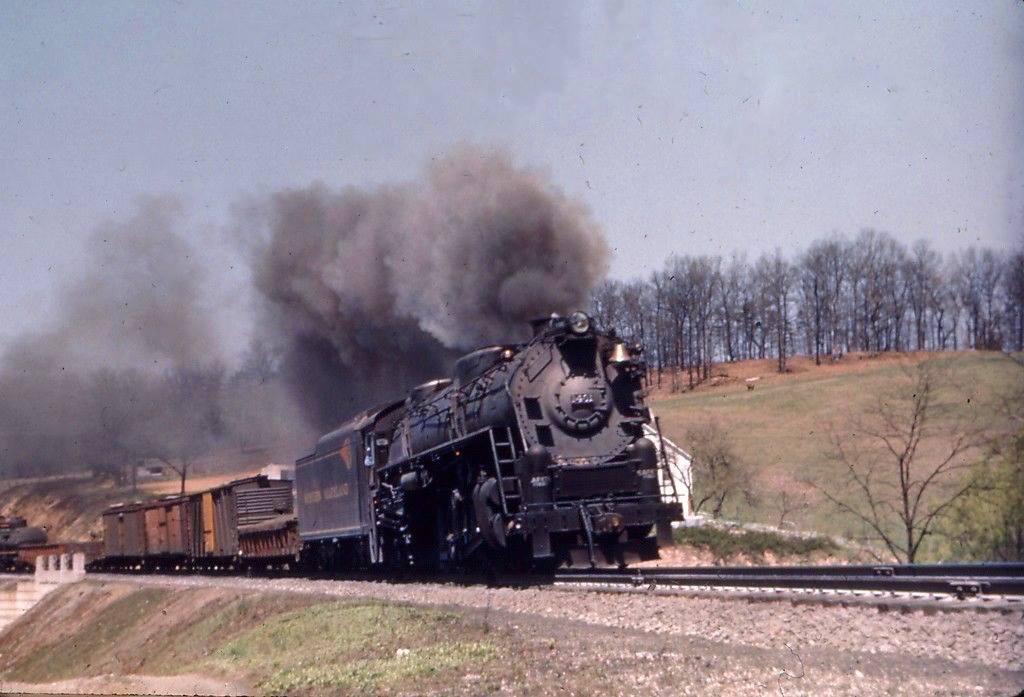
NickD
MegaDork
3/8/21 11:33 a.m.
The weird thing about those Russian Decapods was that the throttles were backwards on them, at least by US standards. On a normal US steam engine the throttle is closed when it's against the backhead and then you pull it out towards you to open it. On these engines, the throttle was closed when it was out away from the backhead and you pushed it forward to open it. So, when the engine would start to lose its footing and slip, engineers would try to rapidly close the throttle to get traction again and would instead accidentally jam the throttle open and spin the wheels furiously. I've heard that Frisco #1630 has it's throttle reversed to standard direction, I'm not sure if this was done by Frisco or Illinois Railway Museum, and whether other railroads performed this modification as well.
Erie loved the damn things, and kept them around for quite a while, as well as selling/leasing a bunch to the NYS&W. The low speed from their 52" drivers helped contriubte to the Weary Erie nickname though.


NickD
MegaDork
3/8/21 1:23 p.m.
When the USRA was allotting the Russian Decapods to US railroads based on perceived need, they originally tried to send a batch to the Pennsylvania Railroad. The PRR tested one and was so unimpressed that they refused to accept delivery of the rest. So their batch was instead sent to the Frisco, who seemed quite fond of them. They installed cross-compound air pumps on the front deck, Nicholson thermic syphons in the boiler, put "doghouses" on the tender and converted some to oil-burning. PRR must have had a special hatred for the Russian Decs, because when they acquired the Detroit, Toledo & Ironton (from Henry Ford himself!), one of the first things they did was scrap the 15 Russian Decapods that the DT&I had ended up with.

One day I should take photos of the CN yard I'm not too far from. I don't know if there is anything interesting about it and wouldn't be able to tell any stories about anything there, but could be neat!

NickD
MegaDork
3/8/21 3:46 p.m.
The Western Maryland also ended up with a batch of Russian Decapods. For some reason, they replaced the cast-iron frames with steel frames and lengthened the frames by 2". No one seems to list a reason why. Since the Wild Mary preferred monstrous motive power and had a reputation as a fast freight mover, these 52" light Decapods seemed out of place.


NickD
MegaDork
3/8/21 4:00 p.m.
Western Maryland's own class of Decapods were the monstrous I-2s. They took their already-huge H-9 2-8-0s and scaled every dimension except boiler diameter up by 30%. The result was a heavy, powerful engine that was abusive to crews and roadbed, due to heavy connecting rods and poor balancing. It was nearly impossible to run the I-2's at speeds above 40 MPH and it was not a pleasant at those speeds. At one time there was an order that anytime an I-2 slipped its drivers the engineer had to report the milepost location and the local track crew was sent to look for broken and damaged rails. On one occasion an engineer on the Baltimore line got mad at his slipping I-2 and allowed it to continue slipping. The track department was not amused when they went out and found 13 rails had to be replaced. The I-2 also resulted in a pissing match with the Reading. They were operated in pool service over the Reading Railroad between Lurgan, Pa and Rutherford, PA. The Reading, tired of replacing damaged rails, decided to ban the I-2 from their railroad. WM answered by banning the Reading's equally heavy and poorly balanced K1 2-10-2s from their railroad. It did not take long for the railroads to determine it was better to put up with each others locomotives than to lose the territory for their own.
Later in life, WM improved their decapods with light weight rods and re-balancing. Some received new disc main drivers. While never really sanctioned by the railroad, hoggers soon found their improved decapods could be operated at speeds of 45 and even 50 MPH. The railroad also raised steam pressure from the original 225PSI to 240PSI, resulting in a 6000 pound increase in tractive effort. Other improvements included thermic syphons, a nonlifting injector paired with an exhaust steam injector, and improved lubrication systems. All in all, the end result was an impressive engine for what was an outdated design when new.
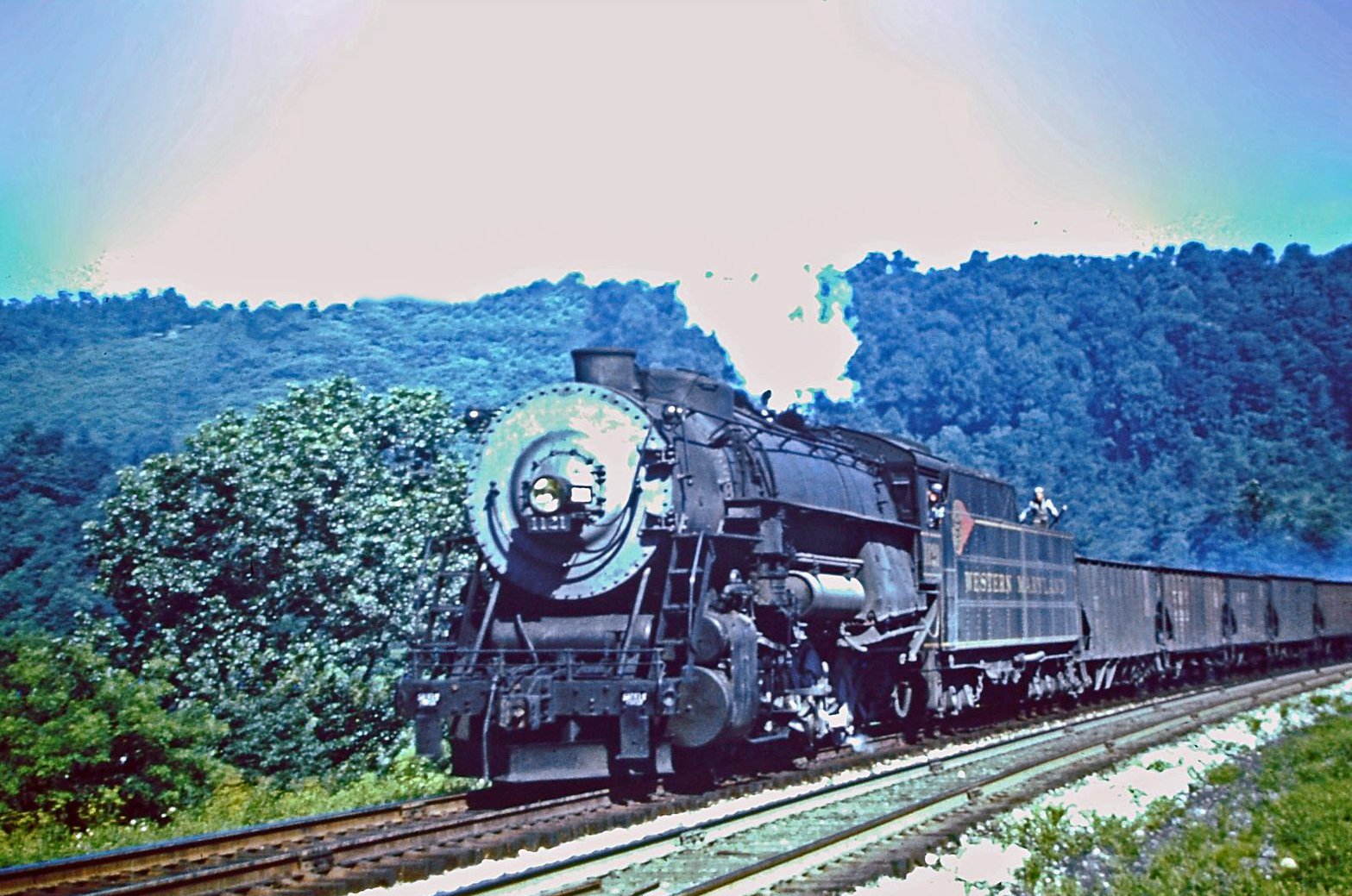

NickD
MegaDork
3/9/21 6:45 a.m.
Two of the Western Maryland's finest, M-2 Challenger #1211 and I-2 Decapod #1114, darken the skies at Williamsport, Maryland with a westbound freight on September 2nd. 1941

NickD
MegaDork
3/9/21 7:56 a.m.
Doubleheaded WM Challengers at The Narrows in Cumberland, Maryland


NickD
MegaDork
3/9/21 8:00 a.m.
The WM Challengers have a weird reputation. A lot of people consider them failures or a poor design. Part of this is attributed to the WM retiring them first, but this actually came down to simple math. In early '52, WM management declared that there would be no major repairs done to steam power, so as they came due for shoppings or suffered failures, they were retired. The Challengers were purchased in '40, and WM replaced the flues every 4 years, so, doing the math, the entire class came due for having their flues replaced in '52. Others point out that the engines were frequently seen in helper service, leading to the belief that they were demoted. While they did often work as helpers but so did every other type of motive power working on Sandpatch Grade. It is important that there were no divisions on the WM that did not have a helper district so the railroad got very good at using power as helpers. In the case of trains over Sandpatch this often meant mid-train as well as rear-end helpers to distribute power. To this end some of the helpers being used on westbound trains up would either stay on the train all the way to Connellsville or cut off and follow the train. If you see a rear end helper that is shoving on a caboose and also has one trailing behind the tender that crew is going on to Connellsville and will bring another train back east. This sometimes resulted in trains with an older Decapods on the head end and a challenger trailing as a rear end helper. In fact the Decapods and Challengers seemed to be used almost indiscriminately on these assignments.
WM did hamstring them when ordering the big articulateds. Roller bearings would have approved efficiency, as would Type E superheaters instead of the Type A they were equipped with. For all the mountain-climbing and heavy coal hauling they did, a trailing truck booster engine was a curious omission. Had the engines been built by Alco, instead of Baldwin, they likely would have incorporated the new-design weight-supporting hinge which would have put more weight on the front engine as well as improved the riding qualities of the locomotives, fixing two gripes of the W-2 (poor ride quality relative to their 4-8-4s and 4-6-2s, and the front engine being wheelslip prone). But all those would have cost extra and increased maintenance costs as well.
Realistically, a fast freight Challenger was probably the wrong choice for the WM. They were designed for moving long trains at relatively high speeds on flat ground, not slogging through mountains. They probably would have been happier with a low-drivered 2-8-8-2 or Yellowstone.


NickD
MegaDork
3/9/21 8:10 a.m.
A Western Maryland Decapod slugging it out on the famed Helmstetter's Curve. There is Challenger shoving hard on the back, out of frame on the left. Since this was taken in '52, that Challenger is running its final days, since WM retired all their Challengers in '52, the first of the WM steam classes to have their fires dropped. The caboose behind the pusher engine means it is likely going to head off to its own destination once it gets the Dec over the hill. Unlike most railroads, who had dedicated helper engines, WM usually assigned helpers in power balancing moves, they helped the train along and got to a destination where they needed more motive power at the same time



NickD
MegaDork
3/9/21 9:45 a.m.
One of the WM's fat-boilered J-1 4-8-4 "Potomacs" at Knobley Tunnel at Carpendale, West Virginia. With the large boiler, plain rectangular number plate on the smokebox, simple V-shaped pilot, and high-mounted headlamp, they had the typical WM look shared with their Challengers and Pacifics, although the bell hung off the side of the smokebox front was unique. These were among the last new design 4-8-4s built, as C&O's and N&W's later machines were reorders of earlier designs. They were short-lived, out of service in '54 and scrapped in '57 when the equipment trusts expired. They were also some of the shortest-drivered 4-8-4s built, with only 69" drivers, and were tremendous performers, nearly matching the M-2 Challenger at 45mph.


NickD
MegaDork
3/9/21 9:53 a.m.
The WM !400-series Potomacs had some very deep, mournful sounding whistles.

NickD
MegaDork
3/9/21 11:11 a.m.
The capped stacks indicate that these 4 Potomacs had been taken out of service and were in storage.


NickD
MegaDork
3/9/21 11:16 a.m.
WM steam power at the Maryland Junction roundhouse. The size difference between the two H-9 Consolidations on the left and the I-2 Decapod next to them is easy to see.
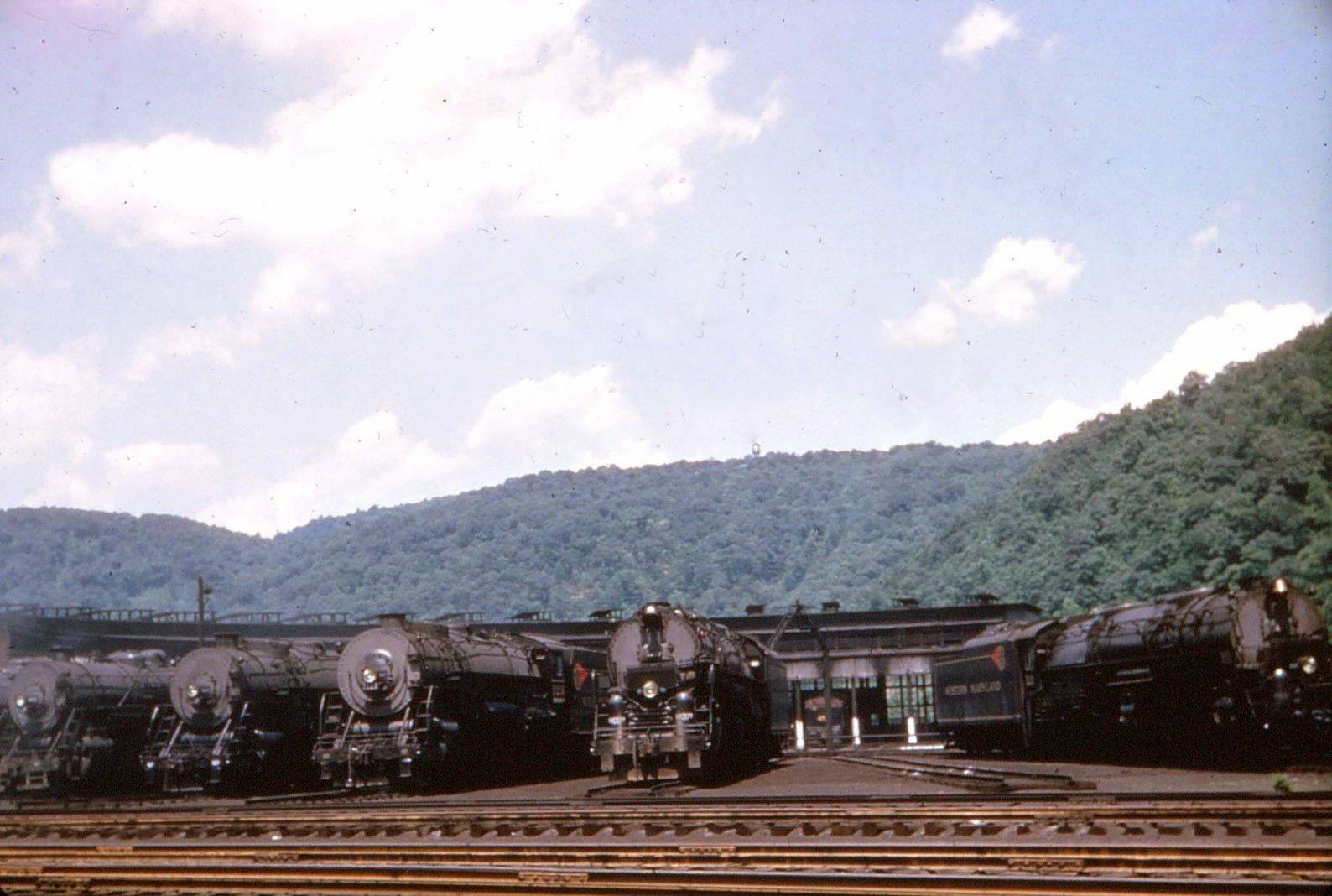

NickD
MegaDork
3/9/21 12:12 p.m.
Never a big passenger hauler, WM never had any named passenger trains, nor did they own any shiny lightweight Budd cars. Their passenger trains were coach-only, two to 4 cars in length, using old heavyweight equipment. They were pulled by their K-2 Pacific, a gutsy 68" drivered engine with the characteristic Wild Mary look. The sole surviving WM traditional steam engine is K-2 #202 at Hagerstown (there is also a big WM Shay preserved and operational at Cass). According to the current chief mechanical officer at Strasburg, in the summer of '82, Hagerstown actually offered the #202 to Strasburg Railroad for $1. He says he was very junior at the time and didn't know what strings were attached to the deal, but Strasburg turned it down. If they had made the deal and taken #202, it would have changed the Strasburg motive power timeline significantly, as PRR #7002 would have never been leased from Railroad Museum of Pennsylvania and operated and they likely wouldn't have acquired Norfolk & Western #475 either.
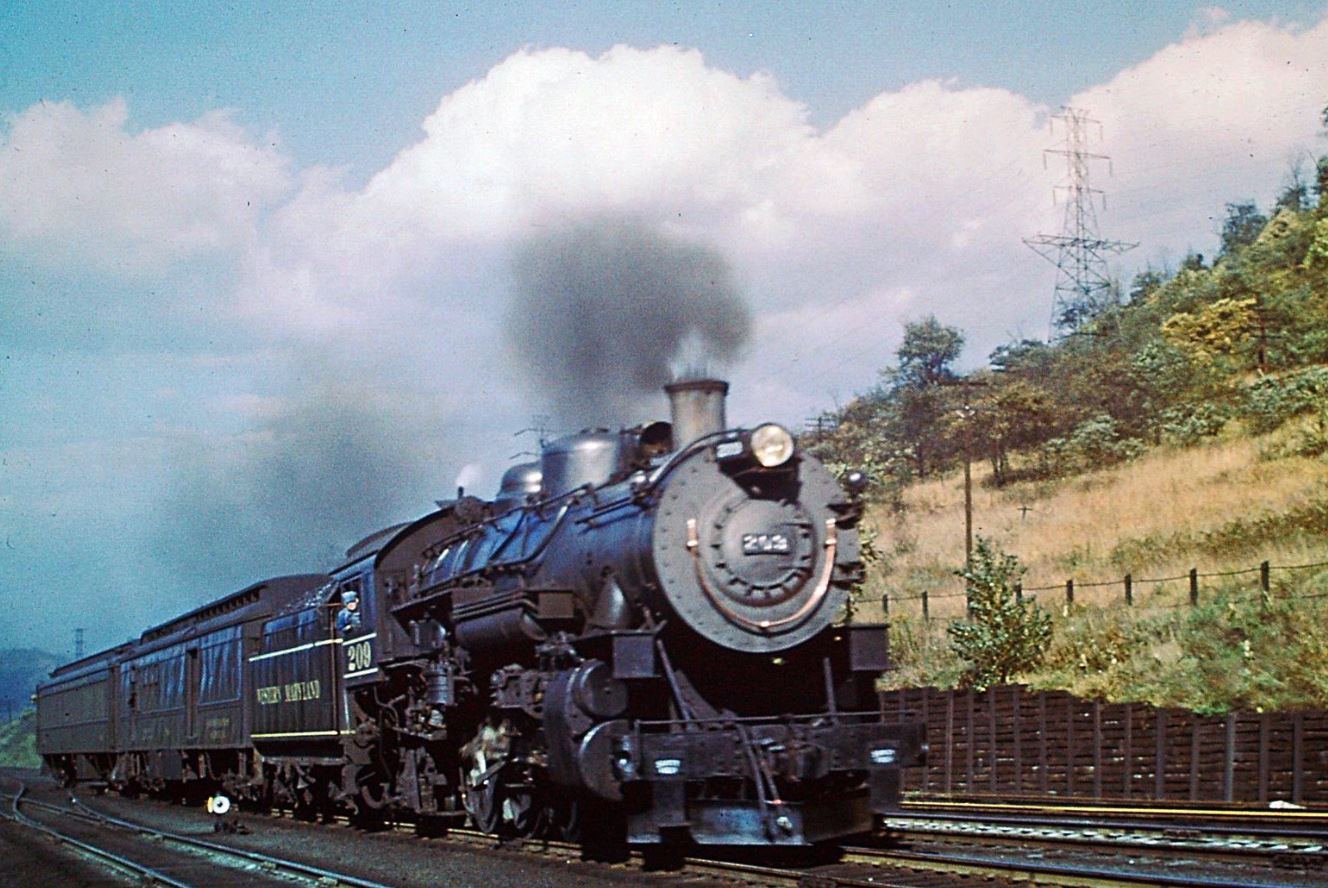

NickD
MegaDork
3/9/21 1:19 p.m.
An amusing remark I read was from a boiler maker who had worked for Western Maryland, PRR and N&W. He said "The Western Maryland bought average engines that they maintained in perfect condition, the Pennsy built superior engines that they maintained in average condition, and the N&W built perfect engines that they didn't maintain at all."
In reply to NickD :
In case you haven't seen this yet, it might just be your calling - Northern Nevada RR is looking for a locomotive mechanic. It seems to be a paid position, though I doubt the pay is great. I imagine housing out there is pretty reasonable though. Positions available.

NickD
MegaDork
3/10/21 7:07 a.m.
In reply to Pete Gossett (Forum Supporter) :
Yeah, I remember Strasburg having job openings and I looked at them. None of them were in the operating or mechanical department but the pay was about half of what I'm currently making. Not so sure I'd want to live in Ely either, as I get the impression it's pretty much the middle of nowhere.

02Pilot
UltraDork
3/10/21 8:08 a.m.
Passed by the restored NYWS&B freight house in Milton, NY yesterday. Not sure what the planned use is for the building, but they've done a nice job on it.


NickD
MegaDork
3/10/21 12:30 p.m.
Boy, mixed feelings on this one. The Texas Railroading Heritage Museum had announced that they will be restoring Southern Pacific/Texas & New Orleans F-1 class 2-10-2 #982 to operation after it was donated to them by the Houston Astros (it was on display at the Minute Maid Park in Houston). That's pretty cool because there are only 6 preserved US-built 2-10-2s and none of them have been operated in restoration. So it would be pretty cool to see one of these big ground-pounders restored to operation.
Why do I have mixed feelings? Well, for starters, it has no tender. The city was looking at moving it from Minute Maid Park to the stillborn Nau Center for Cultural History, and the Nau Center didn't want to make room for the tender. So they sold it off to the Heber Valley Railroad, who has parted out the tender to use for the oil-burning conversion they are performing on their Union Pacific 2-8-0 they are restoring. So currently the #982's tender is in Utah and no longer has the oil bunker or the trucks on it. They are in talks to get back what is left, but it's going to need some reconstruction to be operational again.
The big problem though is that the museum doesn't actually have a site at the moment. The Gulf Coast NRHS chapter ran the Houston Railroad Museum which was evicted from their original site by the landowner back around 2013. Since then, the equipment has been stored in Houston while they try and find a new location. They have since adopted the Texas Railroading Heritage Museum name and has been trying to find a new location for their equipment. For a long time they were in talks with the city of Tomball but BNSF was reluctant to move the old equipment and the TRHM wanted the city to donate $3 million dollars to construct the museum. Things fell apart and now they are looking at a location in Tony Marron Park in Houston.
found this concerning statement on their Facebook page: "We're having discussions about a location in Tony Marron Park. Our biggest problem is that we're rapidly running out of money. We'll need a large cash infusion to get things up and running once we have a site for the museum. Keep an eye on www.texasrrmuseum.org. We'll bring the website back up once we have a site confirmed. People will be able to donate there."
So we have a museum with no webpage, no actual physical site, who is running out of funds saying they are going to restore a very large locomotive that hasn't run in 70 years and has no tender. Not exactly a recipe for success. No word on where they are going to actually run this engine either. An SP F-1 is a large, heavy engine with a long rigid wheelbase that typically operated at slow speeds.

An earlier photo before the tender was sold off.






















